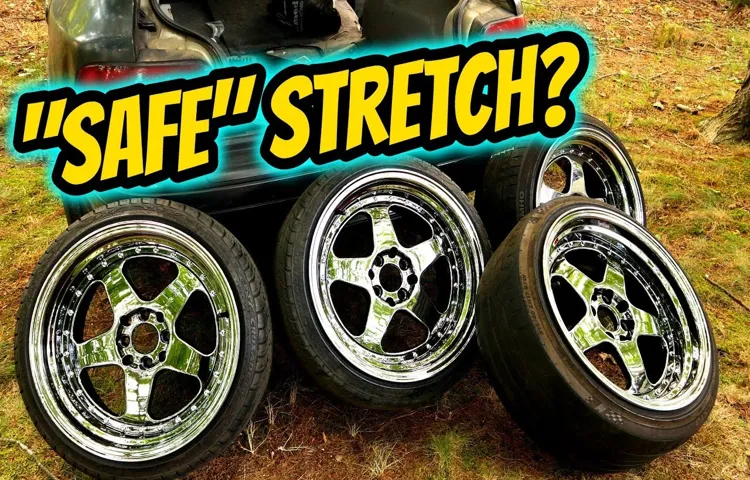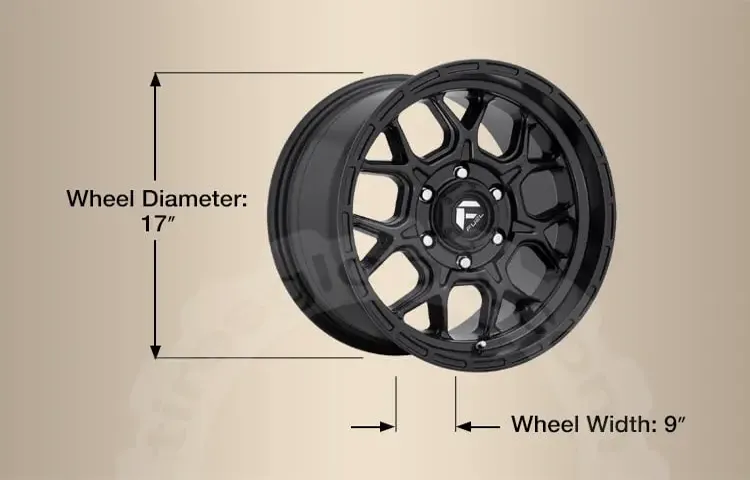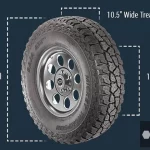If you’re the type of car enthusiast who loves to upgrade their ride, you’ll know that tire sizes can make a big difference in how your vehicle looks and functions. But with so many options out there, it can be hard to know what size tire fits a 17×9 rim. After all, tires come in different widths and aspect ratios, and matching the wrong size could lead to handling issues or even damage to your car.
That’s why we’re here to help you find the perfect fit for your 17×9 rim. Whether you’re into racing or just cruising around town, we’ve got you covered with all the information you need to make an informed decision. So buckle up and get ready to learn everything you need to know about choosing the right tire size for your 17×9 rim!
Table of Contents
Understanding tire sizing
If you’re searching for the right tire to pair with your 17×9 rim, there are a few things you should keep in mind. First, it’s important to understand the sizing system used for tires. The numbers on a tire refer to its width, aspect ratio, and diameter.
For a 17×9 rim, you’ll want to find a tire with a diameter that matches 17 inches. As for width, a tire that’s between 245 and 275 millimeters wide should be a good fit for a 9-inch rim. Keep in mind that the aspect ratio, or the height of the tire, can also affect the fit.
A higher aspect ratio will result in a taller tire, which could cause clearance issues in some vehicles. Consult with a tire professional for specific recommendations based on your vehicle’s make and model to ensure the perfect fit.
Tire sizing explained
When it comes to buying new tires for your car, understanding tire sizing is crucial. The sizing numbers on the tire sidewall might seem like a jumbled mess of letters and numbers, but they actually contain important information. The tire size typically includes three numbers – the first number represents the tire’s width in millimeters, the second number is the aspect ratio (the height of the sidewall relative to the width), and the third number is the diameter of the wheel in inches.
For example, a tire size of 225/50R17 means the tire is 225 millimeters wide, the height of the sidewall is 50% of the tire width, and it’s meant to fit on a 17-inch wheel. It’s important to choose the correct tire size for your vehicle to ensure optimal performance and safety. It’s also worth noting that changing tire size can affect your vehicle’s speedometer accuracy and result in incorrect readings.
So next time you’re shopping for tires, make sure to pay attention to the sizing numbers and consult with a professional if you’re unsure about what size is compatible with your car.

Benefits of correct tire size
Understanding tire sizing is an essential aspect of vehicle maintenance. Ensuring that your vehicle has the correct size tires offers various benefits, including improved handling, better fuel efficiency, and increased safety. The correct tire size also helps to ensure an accurate speedometer and avoids issues with the transmission system.
It is important to note that tire size is not always the same for every car, and understanding the labeling system can be confusing. The size of the tire is indicated by a combination of three numbers, and it is crucial to know their meaning. The first number represents the width of the tire, the second number represents the aspect ratio, which is the height of the tire’s sidewall, and the third number represents the diameter of the wheel.
Proper tire sizing not only improves the performance of your vehicle but also extends the life of your tires. It is always recommended to consult with a professional mechanic to determine the correct tire size and to ensure that all the specifications match the manufacturer’s recommendations.
Factors that determine tire size
When it comes to selecting tires for your 17×9 rim, there are a few factors to consider when determining the right size. Firstly, it’s important to take into account the overall diameter of the tire which will depend on the height of the sidewall. The width of the tire itself is another important consideration since a wider tire can provide better grip and handling in certain situations.
Additionally, the load capacity of the tire should also be taken into account, especially if you plan on carrying heavy loads or going on long-distance drives. To determine the correct tire size for your 17×9 rim, it’s best to consult with a tire specialist who can provide personalized advice based on your driving habits and needs. Overall, selecting the right size tire is crucial for maintaining optimal performance, safety, and efficiency on the road.
Wheel size and width
When selecting tires for your vehicle, one aspect to consider is the wheel size and width. This decision can affect both the performance and appearance of your vehicle. The wheel size typically ranges from 15 to 20 inches, with larger sizes being more common on SUVs and trucks.
A larger wheel size often means a lower profile tire, which can enhance the handling and grip of your vehicle on the road. However, it can also result in a stiffer ride and less cushioning on rough surfaces. Additionally, the width of the tire plays a role in performance.
Widening the tire can provide more surface area for the tire to grip the road, improving handling and traction. However, a wider tire can also increase the risk of hydroplaning and decrease fuel efficiency. It is important to consider your driving needs and preferences before selecting the appropriate wheel size and width for your vehicle.
Tire aspect ratio and section width
When it comes to buying new tires, there are several factors to consider in determining the right size for your vehicle. Two of the most important factors are the tire aspect ratio and section width. The aspect ratio refers to the height of the tire sidewall as a percentage of the tire’s width, while the section width is the measurement of the tire’s widest point in millimeters.
Together, these two measurements give you a good idea of a tire’s overall size. The aspect ratio plays a crucial role in determining a tire’s handling and ride quality. Tires with a lower aspect ratio (such as 40 or 45) tend to provide better handling and a sportier look, while tires with a higher aspect ratio (such as 65 or 75) offer a more comfortable ride.
The section width of a tire also affects handling and ride quality, as wider tires provide more stability and grip on the road. In addition to these factors, it’s important to consider the load index and speed rating of your tires. The load index indicates how much weight each tire can support, while the speed rating tells you the maximum speed that the tire is designed to handle safely.
These ratings are important to ensure that your tires can safely accommodate the weight of your vehicle and provide the appropriate level of performance and durability. Overall, understanding tire sizes and ratings can be confusing, but it’s important to take the time to research and choose the right tires for your vehicle. By considering factors such as aspect ratio, section width, load index, and speed rating, you can ensure that you get the best possible performance and safety from your tires.
Vehicle weight and load capacity
When choosing the appropriate tire size for your vehicle, it’s important to consider several factors, such as the vehicle’s weight and load capacity. The tire size is crucial because it impacts the vehicle’s overall performance and safety on the road. The tire’s load index is measured based on how much weight it can carry and maintain adequate performance.
When choosing a larger tire size than what’s recommended for your vehicle, it may adversely affect its fuel efficiency, handling, and braking distance. On the other hand, if you opt for a smaller tire size, it may not handle the vehicle’s weight, making it more susceptible to blowouts and other hazards. In summary, stick to the recommended tire size that your vehicle manufacturer specifies in the owner’s manual to ensure optimal performance and safety.
Recommended tire size for 17×9 rim
If you’re considering changing your wheel size and wondering what size tire will fit on a 17×9 rim, there are a few things to keep in mind. The recommended tire size for a 17×9 rim will depend on the type of vehicle you have, your driving style, and the terrain you’ll be driving on. Generally, a 245 or 255 width tire works well for a 17×9 rim.
The aspect ratio of the tire should also be considered, as it will affect the height of the tire. It’s recommended to consult with a professional when choosing the right tire size for your 17×9 rim to ensure optimal performance, handling, and safety on the road. Remember, proper tire selection is crucial for vehicle stability, handling, and overall ride quality.
Tire size chart for 17×9 rim
If you’re looking for the recommended tire size for a 17×9 rim, then you’ve come to the right place. The ideal tire size for a 17×9 rim would be 255/40R1 This tire size will provide you with the best balance of performance, comfort, and handling.
You can also choose a slightly wider tire size like 265/40R17 for a more aggressive look and better grip, but this could negatively impact the ride quality. On the other hand, if you opt for a narrower tire size like 245/45R17, you might experience tire squirm and reduced cornering performance. It’s important to choose a tire size that fits your vehicle and driving needs perfectly since it can affect the way your car handles and performs on the road.
By getting the right tire size, you can maximize your driving experience while avoiding any unwanted safety issues.
Factors to consider in choosing the right tire size
When it comes to choosing the right tire size for a 17×9 rim, there are a few factors to keep in mind. First, consider the intended use of the vehicle. If you plan on primarily using it for street driving, a tire with a lower profile may be more suitable.
However, if you plan on taking your vehicle off-road or on rough terrain, a tire with a taller profile and more aggressive tread pattern may be necessary. The size of the tire itself should also be taken into account, as a tire that is too big or small for the rim can lead to handling issues and even damage to the wheel. When looking for tires for a 17×9 rim, it is recommended to stick with a size of 255/40R17, which offers a good balance between performance and durability.
Ultimately, it is important to choose a tire size that fits your specific needs and driving style, while also ensuring that it is compatible with your rim size and vehicle.
Conclusion and final thoughts
In conclusion, determining the size tire that will fit on a 17×9 rim requires a delicate balance of science and art. Tire size, width, and aspect ratio must be taken into account, but it’s also important to consider the desired look and performance of your vehicle. So, whether you want to go big and bold or keep it sleek and understated, with the right tire and rim combination, you’ll be rolling in style and hitting the road with confidence.
“
FAQs
What is the maximum tire size for a 17×9 rim?
The maximum tire size that will fit on a 17×9 rim will depend on the specific make and model of the vehicle. However, a common recommended size is 275/40R17.
Can I put a wider tire on a 17×9 rim?
Yes, you can put a wider tire on a 17×9 rim. However, it is important to ensure that the tire width is within the recommended range for your specific vehicle.
What is the ideal tire width for a 17×9 rim?
The ideal tire width for a 17×9 rim will depend on the specific make and model of the vehicle. However, a common recommended range is between 245mm-285mm.
Can I use a tire with a lower profile on a 17×9 rim?
Yes, you can use a tire with a lower profile on a 17×9 rim. However, it is important to ensure that the overall diameter of the tire is within the recommended range for your specific vehicle.
What is the recommended bolt pattern for a 17×9 rim?
The recommended bolt pattern for a 17×9 rim will depend on the specific make and model of the vehicle. However, common bolt patterns for a 17×9 rim include 5×114.3mm and 5x120mm.
How do I determine the backspacing for a 17×9 rim?
The backspacing for a 17×9 rim will depend on the specific make and model of the vehicle. It is best to consult with a professional or refer to the manufacturer’s recommendations to determine the proper backspacing.
Can I use a tire with a higher load rating on a 17×9 rim?
Yes, you can use a tire with a higher load rating on a 17×9 rim. However, it is important to ensure that the load rating is appropriate for the weight of your vehicle.



